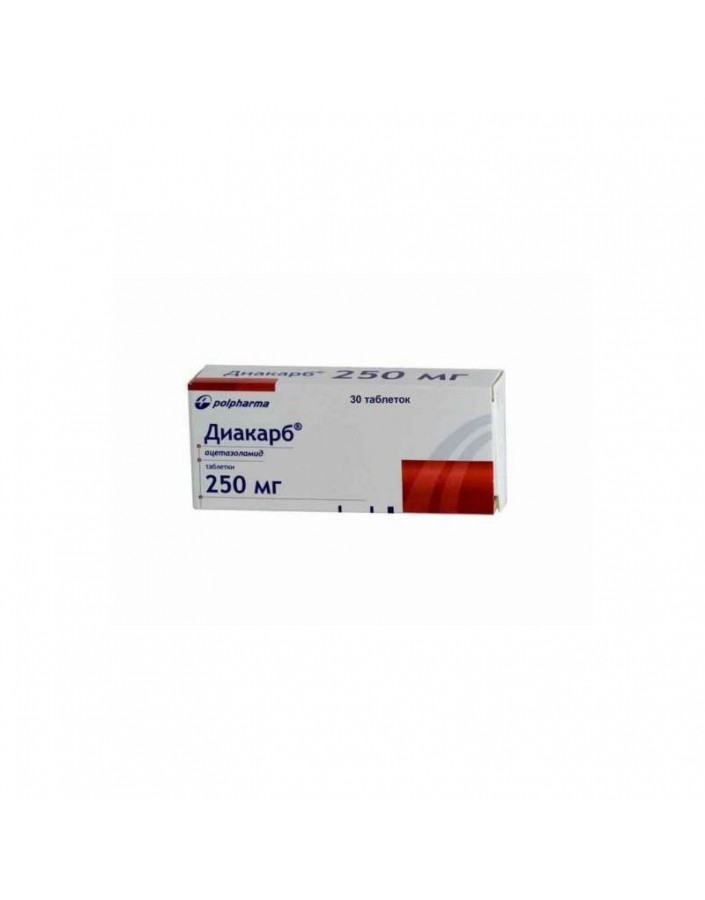




Security policy (edit with Customer reassurance module)

Delivery policy (edit with Customer reassurance module)

Return policy (edit with Customer reassurance module)
1 pill contains:
active substance: acetazolamide 250 mg
Excipients: potato starch, talc, sodium starch glycolate.
30 pieces
Diacarb is a weak diuretic. Inhibits the enzyme carbonic anhydrase in the proximal convoluted nephron tubule, increases the excretion of Na ions with urine+ and K+, bicarbonate, does not affect the excretion of Cl-ions, alkalizes urine. Violates the acid-base state (CBS) (metabolic acidosis). Inhibition of carbonic anhydrase ciliary body leads to a decrease in the secretion of aqueous humor and a decrease in intraocular pressure. Suppression of carbonic anhydrase activity in the brain causes the presence of antiepileptic activity. Duration of action - up to 12 hours.
Edematous syndrome (mild and moderate severity, in combination with alkalosis), glaucoma (primary and secondary, acute attack), epilepsy (as part of combination therapy), mountain sickness.
Hypersensitivity to the components of the drug Diakarb, acute renal failure, liver failure, hypokalemia, acidosis, hypocorticism, Addison's disease, uremia, diabetes mellitus, pregnancy, lactation.
With caution - edema of the liver and kidney genesis, taking high doses of Acetylsalicylic acid.
The drug is taken orally, strictly on doctor's prescription.
Edema syndrome
At the beginning of treatment, 250 - 375 mg (1 - 1 ½ tablets) 1 time per day - in the morning.
The maximum diuretic effect is achieved when taking the drug every other day or two days in a row, and then a one-day break.
When applying Diacarb, it is necessary to continue the treatment recommended for circulatory failure, for example, with digitalis glycosides, to observe the restriction of salt intake in the diet and to compensate for the lack of potassium.
Glaucoma
Adults are usually prescribed:
Epilepsy
Adults: 250 - 500 mg / day in a single dose for 3 days, on the 4th day of a break.
Children: 4-12 months 50 mg / day in 1 - 2 doses, 2-3 years: 50 - 125 mg / day in 1-2 doses, 4-18 years: 125 - 250 mg once in the morning.
With the simultaneous use of Diacarb with other anticonvulsants, at the beginning of treatment, 250 mg (1 tablet) is used 1 time per day, gradually increasing the dose if necessary.
Children should not use doses higher than 750 mg per day.
Mountain sickness
The use of the drug in a dose of 500-1000 mg (2-4 tablets) per day in equal doses is recommended.
In the case of rapid ascent - 1000 mg (4 tablets) per day in equal doses.
The drug should be applied 24 - 48 hours before climbing, and in case of symptoms of the disease - continue treatment for the next 48 hours or longer, if necessary.
In case of skipping the drug, at the next dose, do not increase the dose.
Hypokalemia, muscle weakness, convulsions, skin flushing, paresthesia, tinnitus, anorexia, metabolic acidosis, pruritus, myopia, urticaria. With prolonged use - nephrolithiasis, hematuria, glucosuria, hemolytic anemia, leukopenia, agranulocytosis, disorientation, impaired touch, drowsiness, nausea, vomiting, diarrhea, allergic reactions, paresthesia.
In the case of the appointment of the drug for more than 5 days, the risk of developing metabolic acidosis is high.
With prolonged use should be monitored indicators of water electrolyte balance, the picture of peripheral blood, KOS.
Strengthens manifestations of osteomalacia caused by taking antiepileptic drugs.
Combination with other diuretics and theophylline increases the severity of the diuretic action.
Acid-forming diuretics weaken the severity of the diuretic effect.
Increases the toxicity of salicylates, digitalis preparations, Carbamazepine, ephedrine, non-polarizing muscle relaxants.
In case of drug poisoning, consult a doctor immediately.
Cases of drug overdose or acute poisoning are not described. Symptoms of overdose - increased side effects.
Treatment: symptomatic.
Store in a dry, dark place and out of reach of children, at a temperature below 25 ° C.
Diacarb